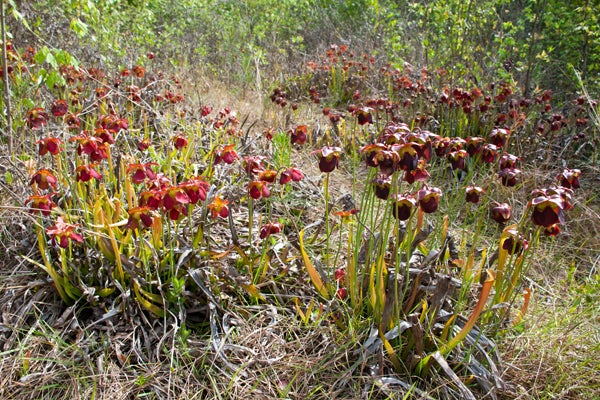
By Justin Averette
Chilton County is known across the country for its peaches — and rightfully so.
Anyone who has ever bitten into, or maybe drunk is a better word, a juicy Loring on a blistering July day can tell you why.
But there’s another, much lesser known plant found here that doesn’t grow anywhere else on Earth.
A federally endangered species, the Alabama Canebrake Pitcher Plant can only be found in a few locations in Chilton, Autauga and Elmore counties. It’s a carnivorous plant — sort of a distant cousin to the Venus flytrap — that traps and digests insects for nutrients.
But the pitcher plant doesn’t use a quick spring to trap its pray. It relies instead on its shape to catch an unsuspecting fly or unlucky cricket.
Foraging, flying or crawling insects are attracted to the plant by its color and nectar. Once at the pitcher’s edge, they slip on the slippery surface. As they work to free themselves, they slide further down until they can’t climb back out again.
The plants only grow in wet areas that have full sunlight, said Brian Smith, Chilton County management specialist with the Alabama Forestry Commission.
One of the biggest boughs around is on Ralph Mims’ property near Billingsley in Autauga County.
Mims bought his land in 1955 after studying at Auburn University and getting out of the Air Force, but said he knows the plants have been there since at least 1952.
The pitcher plants can be found in on a few of his neighbors’ properties too, he said.
Groups from botanical gardens in Atlanta and as far away as London have periodically done work in the bough, like cutting away undergrowth that would have choked the plant. They have also burned in the area, which is beneficial too.
“They need open sunlight. They don’t do well in the understory,” Smith said.
In the spring and early summer, the pitcher plant produces a maroon flower that adds to its mystique.
The plant produces significantly different pitchers in the spring and summer, according to the book “Endangered and Threatened Species of the Southeastern United States.” The spring pitchers are smaller (20 to 50 centimeters) and curved.
It’s in the summer when the pitchers are most striking. During these months, the plants grow to up to 70 centimeters, stand erect, are light green in color and covered in a fine hair.
In the 1990s, the U.S. Fish and Wildlife Service estimated that there were only 12 sites where the pitcher plant grew. They were all on private land with five in Chilton and Autauga counties and two in Elmore County. Historically, the plant was found in about 28 locations. The majority of today’s populations have fewer than 20 plants.
The pitcher plant grows in sandy and gravelly bogs, particularly in swampy areas in highly acidic sand. Plants that might grow in similar areas include cane, bamboo-vine, sweet bay, alder, red maple, poison sumac and wax myrtle, according to the Department of Interior.
